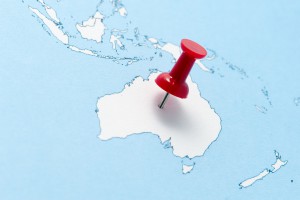What’s ahead for property in 2018?
Yesterday we started our 4 part series on the state of play of the Australian housing markets.
If you missed it you can read it here.
Today let’s look at a few more aspects including:
- A demographic overview
- Interest rates, and
- Household finance
Demographic Overview 
The annual rate of national population growth has steadied recently.
It was estimated that at the end of the June 2017 quarter, the national population was 24,598,933 persons.
Australia’s population increased by 1.6% or 388,124 persons over the 12 months to June 2017.
While net overseas migration has accelerated, natural increase has slowed.

Source: Corelogic
Net overseas migration is the main driver of the strong rate of population growth
Population growth nationally is comprised of net overseas migration as well as the natural increase in the population (births minus deaths). Statebased migration also includes net interstate migration which cancels out at a national level.
Net overseas migration was recorded at 245,408 persons over the 12 months to June 2017 which was 27.1% higher than at the same time in 2016 and at its highest level since December 2009.
Natural increase fell by -7.5% over the year and was recorded at 142,716 persons.
The national rate of annual population growth peaked at 2.2% in December 2008 when the population increased by 459,504 persons over the quarter, of which net overseas migration was recorded at 315,687 persons.
Although the rate of population and overseas migration has slowed relative to the 2008 peak, it remains elevated and is much higher than in most other developed countries throughout the world.

Source: Corelogic
Victoria remains the population growth powerhouse of the nation
The population of New South Wales increased by 1.6% or 121,794 persons over the 12 months to June 2017. 
The annual population increase was 8.9% higher over the year and slightly lower than its record high.
Victoria’s population increased by a nation-leading 2.3% over the 12 months to June 2017 with the population increasing by 144,357 residents over the year.
The total change in population over the year was -1.3% lower than over the previous year.
With an increase of 79,580 persons over the year to June 2017, Queensland’s population increased by 1.6% over the year.
The 79,580 person increase in population was the greatest annual population increase for the state since September 2013 and 23.4% higher than the population increase a year earlier.
South Australia’s population increased by 10,494 persons over the 12 months to June 2017 resulting in a population growth rate of 0.6%.
The 10,494 person increase in population was slightly higher than the previous quarter but -6.4% lower than over the previous year. 
The population of Western Australia increased by 21,403 persons or 0.8% over the past year.
Although Western Australia is seeing an historically slow rate of population growth, the state’s annual change in population lifted (from a low base) by 45.8% over the past year.
The Tasmanian population increased by 3,289 persons or 0.6% over the 12 months to June 2017.
The 3,289 increase was the greatest annual population increase since December 2010.
Northern Territory’s population increased by 0.1% or 365 persons over the 12 months to June 2017, a -53.0% decline on the increase a year earlier.
In the Australian Capital Territory, the rate of population growth was recorded at 1.7% over the past year resulting in an increase in population of 6,833 persons.

Source: Corelogic
More than three quarters of net overseas migration has been into NSW or Vic
Most of those people immigrating to Australia continue to choose to settle in either NSW or Vic with net overseas migration over the past year recorded at record highs of 98,570 persons in NSW and 86,901 persons in Vic.
NSW accounted for 40.2% of net overseas migration nationally and Vic accounted for 35.4%, if you add in the 12.7% in Qld, the three most populous states accounted for 88.3% of national net overseas migration.
With net overseas migration of 98,570 persons over the past year, New South Wales recorded its greatest volume of net overseas migrants on record and the number was 31.4% higher compared to the previous year. 
The net overseas migration of 86,901 persons into Victoria over the past year was the greatest number on record and 23.1% higher than the previous year.
Queensland’s net overseas migration was recorded at 31,148 persons over the past year which was 44.3% higher than the number of overseas migrants at the same time a year earlier and the highest number since March 2014.
Over the past year there were 10,497 net overseas migrants to South Australia which was 4.6% higher than the number a year earlier.
Net overseas migration to Western Australia is well below historic peaks however, the 13,101 net migrants to the state over the past year was 7.9% higher than over the previous year.
Net overseas migration for Tasmania was recorded at 1,461 persons which was 30.0% higher than a year earlier and its highest annual number since June 2010.
The 923 net overseas migrants to the Northern Territory over the past year was 58.0% higher than the number over the previous year but still well down on recent levels.
The Australian Capital Territory had net overseas migration of 2,801 persons over the past year which was 42.9% higher than the number over the previous year.

Source: Corelogic
Queensland now leads the pack in terms on net interstate migration over the past year
The net outflow of New South Wales residents to other states and territories was recorded at 14,859 persons over the past year, its greatest decline since March 2013.
Victoria recorded a net gain from interstate migration of 17,182 persons which is slightly down on its historic high level of gain the previous quarter however, it is 2.9% greater than over the previous year.
Net interstate migration to Queensland was recorded at 17,426 persons over the past year, its greatest increase since December 2008, 50.5% higher than over the previous year and now the nation’s leading state for net interstate migration.
South Australia recorded a loss of 5,941 persons over the past year due to net interstate migration which was lower than over the previous quarter as well as being lower than the net loss of 6,398 residents a year earlier.
After annual net interstate migration peaked at 11,425 persons in September 2012, Western Australia has recorded a loss of 11,722 residents over the past year, which is a slightly lower net loss than the record-high annual loss over the previous quarter.
Net interstate migration to Tasmania saw a net gain of 741 residents over the past year, which was its strongest net inflow since September 2009.
The net loss of 3,490 residents from the Northern Territory over the past year was its greatest outflow on record.
The Australian Capital Territory has recorded a net inflow of residents from other parts of the country of 663 persons, which is slightly lower over the quarter.

Source: Corelogic
Mortgage rates have been lifted despite the cash rate holding at record lows
At their December 2017 meeting, the RBA kept the official cash rate on hold at 1.5%. 
For an owner occupier, average mortgage rates are currently recorded at: 5.20% for a standard variable mortgage, 4.5% for a discounted variable mortgage and 4.10% for a three year fixed rate.
For investors, current average mortgage rates are: 5.80% for a standard variable mortgage, 5.10% for a discounted variable mortgage and 4.45% for a three year fixed mortgage.
Mortgage premiums for investors have only been in place for slightly more than two years and were introduced in response to the heightened level of purchasing by this market segment.
Investors on variable mortgage rates are now typically paying 60 basis points more than owner occupiers (and premiums are even greater for interest-only mortgages) which is a significant contributor to the slowing mortgage demand.

Source: Corelogic
Gross household and housing debt continues to rise to new record highs
The national ratio of household debt to disposable income was recorded at 199.7% in September 2017, up from 199.3% the previous quarter and 191.3% a year earlier. 
The 199.7% ratio of household debt to disposable income is largely made up of housing debt which has a record-high ratio of 137.5% up from 136.8% the previous quarter and 131.7% a year earlier.
Of the 137.5% ratio of household debt to disposable income, 104.7% of the 136.4% is owner occupier debt (also a record-high) leaving 33.8% to investors.
Although household and housing debt is at historic high levels, the ratio of total interest payments to disposable income sits at 8.8% for total debt and 7.2% for housing debt, both of which have edged slightly higher of late yet also indicating that lower interest rates have improved serviceability which is at levels last seen in early 2003.
The high level of housing and household debt makes households much more sensitive to any changes in mortgage rates.
Also remember that this is a national view; home owners that have had their mortgage for many years are likely to be in a stronger position while recent buyers may be in much higher levels of debt.
Household Finances
While housing and household debt are at record highs, the ratio of household and housing assets to disposable incomes is also at near record highs.
As at the end of the September 2017 quarter, the ratio of household assets to disposable income was recorded at 952.1% and the ratio of housing assets to disposable income was recorded at 521.8% 
A year earlier these ratios were recorded at 900.6% for household assets and 486.0% for housing assets, indicating that asset values have risen at a faster pace than debt.
It is undeniable that households are heavily indebted, largely due to housing however, the macro view is that these assets have a significantly higher value than the debt held against them.
Of course the macro view does not show what is occurring in individual properties or locations, households that have recently taken out large debt (such as a mortgage) and those who own homes where values have fallen over recent years are likely to be in a much weaker position than these figures indicate.
Furthermore, were asset values to start falling it is unlikely that the debt would decline at an equivalent rate.

Source: Corelogic
Annual wage growth has increased slightly but wage rises remain sluggish
The ABS wage price index showed that over the 12 months to September 2017, wages increased by 2.0%, slightly higher than their historic low of 1.9%.
Separating the data into private and public sector wages shows that private sector wages increased by 1.9% over the year and public sector wages were 2.4% higher.

Source: Corelogic
The ABS has been producing this dataset since late 1997 and the growth in wages for both the private and public sector is only slightly above historically low levels.
Lower wages growth impacts on a household’s ability and willingness to spend more, particularly on items such as rent and other non-essential spending.
The low rate of growth in wages appears to have not had any impact on the growth in dwelling values, but is likely a key driver of weak retail spending and a softening in household saving and increasing indebtedness.
You may also be interested in:
AUSTRALIAN RESIDENTIAL PROPERTY MARKET & ECONOMIC UPDATE FEB 2018: PART 1
No comments:
Post a Comment